Some 30 GIs are grouped at the edge of an Iraqi village, awaiting the arrival of a Specialized Search Dog team. In time, a helicopter arrives and offloads two passengers. The two-legged member of the SSD team is Army SSgt. Kevin Reese.
The other one is Grek, a yellow Labrador retriever wearing goggles and earmuffs for eye and ear protection during his flight.
Reese briefs the unit on Grek’s capabilities: He operates off-leash out to 656 feet and is trained to detect the odors of most explosives as well as firearms. When Grek encounters an explosive odor, he sits to indicate its presence. He’s proficient at searching open areas, vehicles, buildings, and routes.
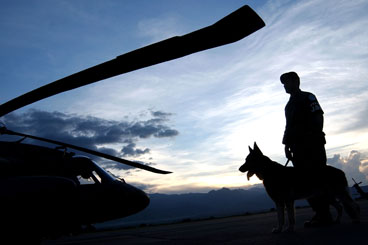 |
TSgt. David Adcox restrains his military working dog Samo at a training demonstration. (USAF photo by SrA. Mike Meares) |
And he’s fast. Grek will search a house or courtyard thoroughly in as little as two minutes, thereby minimizing time spent in a danger zone and limiting the troops’ exposure.
The soldiers who gathered around Grek were well aware of these facts. They had requested an SSD team, and Grek by name. He is a star in those parts—prior experience has led the soldiers to appreciate his considerable skills.
Then, it was showtime. In a flash, Grek did his thing, and soon indicated there were no explosives on hand. The troops trudged forward once more, weary but confident they would not shortly be blown to bits.
Specialized Search Dogs serve as one of the best of all tools against improvised explosive devices, or IEDs—the roadside bombs that have caused most of the US casualties in Iraq. In fact, American forces have found nothing that will consistently outperform a military working dog’s detection abilities, especially in a dirty environment.
Tactics have evolved in the IED battle. Radio-frequency triggers have given way to pressure switches and movement triggers. The bomb-makers can change the triggers or the tactical scenario, but fortunately the one thing they cannot change or hide is the odor of the device’s explosives.
Today, the Air Force is going after the IED threat from the rear, by training the dog-and-handler teams to find IEDs and the bomb-makers’ materiel caches, to disrupt the explosives supply chains.
Grek is the product of a Specialized Search Dog Program conducted by the Air Force at Lackland AFB, Tex. USAF is the executive agent for the DOD Military Working Dog Program. The Army needed a better way to thwart IEDs in Afghanistan and Iraq, and the SSD team concept is aimed at providing it.
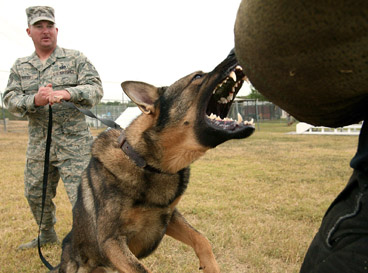 |
SSgt. Rafael Melendez and Houston patrol the flight line at Soto Cano Air Base in Honduras. (USAF photo by Robbin Cresswell) |
In 2003, up to 60 percent of all insurgent attacks began with an IED detonation, often followed by direct fire. However, increasingly, more and more attacks have become IED stand-alone affairs as insurgents employ hit-and-run tactics.
The Nose Knows
As science uncovers new facts on canine performance, the role of dogs in the military will become even more important.
“The dogs’ vapor sensing capability far surpasses the capability of modern measurement techniques,” noted a 2002 Sandia National Laboratory report on the smell sensitivity of mine detection dogs. “Even so, with extrapolation and estimation techniques, we find that the dog is capable of sensing at extraordinary low levels, levels that approach that of one molecule per sniff.”
Explosive-sniffing dogs have a long and illustrious history.
In the early days of World War II, military dogs were used primarily as sentries. Later in the war, they were used as scout and patrol dogs, messenger dogs, and mine detection dogs. The Army acquired more than 19,000 dogs during the war, but approximately 45 percent were rejected as unsuited for training.
The mine detection dogs (M-dogs) during World War II proved unreliable and thus were not heavily used. Later analysis revealed faulty training methods. During the Vietnam era, the M-dogs proved their worth.
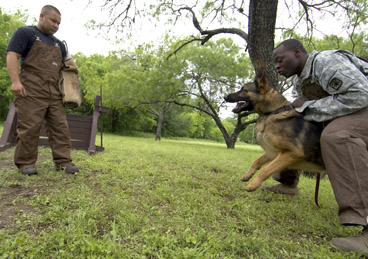 |
Air Force SSgt. Adolph Rodriguez (l) and Army Sgt. Brodrick Kimble (r) work as a team to teach a military working dog to attack and release on command. (USAF photo by TSgt. Matt Hannen) |
More than 9,000 dog handlers served during the Vietnam War. Their dogs included sentry and patrol dogs, scout dogs, tunnel dogs, mine dogs, and tracker dogs.
Mine dogs and tunnel dogs worked off-leash up to 120 feet away from their handlers. The mine dogs worked primarily along roads and railroad tracks searching for mines, booby traps, and trip wires. Tunnel dogs were trained to find trip wires and tunnels, and signaled a find by sitting about two feet from the tunnel entrance or trip wire.
The Army opened its first tracker dog program during the Vietnam War and turned to the British for help. The British Jungle Warfare School in Malaysia had been in operation since World War II and had seen counterinsurgency success in Kenya, Cypress, and Borneo.
To provide the nucleus of a tracker dog program, the US Army sent two platoons through the JWS. The British used Labrador retrievers for the tracker function.
During the Vietnam War in the 1960s and 1970s, scout, tracker, and mine/tunnel dogs piled up impressive statistics. Based on summaries of monthly after-action reports, scout and mine/tunnel dog teams conducted some 84,000 missions. These dogs were responsible for thousands of enemies killed and captured. They located supply caches, mortars, and exposed at least 2,000 tunnels and bunkers.
Today, the “customer” for the search dog teams is the Army field unit. Col. Randal G. Martin, commander of the Alabama Army National Guard 1169th Engineer Group, returned last September from a one-year tour in Iraq. Martin commanded five SSD teams that executed a number of finds and encountered very few false positives.
Two types of dogs are used for explosive detection. One is the mine detection dog that works on-leash and performs detailed coverage and clearance of minefields. The other is the Specialized Search Dog that works off-leash and searches for arms and explosives on roads and routes and in open areas, buildings, and vehicles.
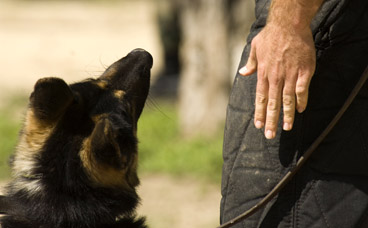 |
During a training session at Lackland AFB, Tex., a working dog reacts to his trainer’s voice commands and nonverbal gestures. (USAF photo by TSgt. Matt Hannen) |
Many Values
In 2002, Gen. John M. Keane, then Army vice chief of staff, directed the US Army Engineer Regiment to establish a dog detachment at Ft. Leonard Wood, Mo.
Jim Pettit, a civilian employee of the US Army Engineers at Ft. Leonard Wood, knew of the British Army’s Arms and Explosive Search Dog Program and sent six Army engineers to England, where they went through the Defense Animal Center AES training course.
After completing the course, in 2004 these engineers deployed with their search dogs to Iraq. Their success in that theater generated a great demand for more SSD teams.
During 2005, Pettit trained 21 SSD teams at Ft. Leonard Wood. Their continuing success resulted in the SSD program moving to Lackland Air Force Base, under the umbrella of Air Education and Training Command’s 341st Training Squadron. Tim Ori, director of operations for the 341st, got the course up and running at Lackland and added input from his observations of the Israeli Defense Force K-9 Unit.
Martin enumerated the value of the SSD teams.
First, they help take IEDs off the streets. He noted that after successful cordon and search operations with plenty of finds, there would follow a period with a reduction in numbers and quality of IEDs on the street.
Second, they reduce exposure. Martin noted that an SSD team can clear a three story building in as little as four minutes, thus allowing troops to finish searching a neighborhood quickly.
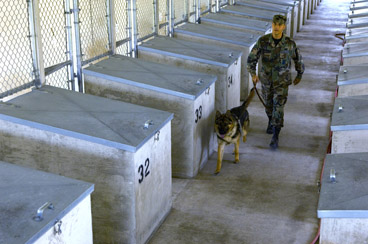 |
Air Force SSgt. Shawn Alexander, after a day of training exercises, returns a dog to the kennel at Lackland. (USAF photo by TSgt. Matt Hannen) |
Third, the dogs boost morale. Martin arranged for periodic SSD missions to put the dogs in contact with his soldiers. He felt the opportunity to spend a little bit of time with a friendly Labrador retriever was a very effective stress reliever for GIs. Interviews with dog handlers echoed the refrain of the value of the dogs as a morale booster. Every handler mentioned the frequency of GIs thanking him or her for being there with the dog, because the teams save lives and provide a comforting canine companion.
The training of explosive detection dogs is international in scope. Currently the United Kingdom leads the world in training explosive detection dogs, with the British Army producing some of the highest quality dogs available.
One veteran of the British Arms and Explosive Search Dog Program is Paul C. Bunker, who had extensive experience as a handler and canine training instructor. He has brought his international expertise to Lackland as an SSD instructor.
Trained to Train
“The British Army has such a good AES Dog Program because it has been involved in counterinsurgency operations since World War II,” said Bunker. “They were in Aden, Yemen, Cypress, Bosnia, and Northern Ireland.” These operations gave great impetus and motivation to developing an effective detection dog program.
Bunker touted great searching speed as a major benefit of an AES dog, which can search 10 times faster and search 10 times more area with a much greater degree of thoroughness than a human.
He also highlighted the value of AES dogs in finding secondary devices. As Bunker reported, the Irish Republican Army in Northern Ireland was crafty about setting up secondary devices in locations where responders to the first device were likely to gather.
Many lives were saved by dogs finding the secondary devices before they could be triggered.
The SSD course is headed by Orlando Nunez, a civilian Air Force employee with a 10-year history as an Army dog handler. Nunez manages 28 instructors, including four British Army retirees, two US marines, and 22 US Army instructors. Those instructors currently train approximately 100 SSD teams per year, with the bulk of the classes conducted at Lackland.
The success of the SSD teams depends on the cooperation and skills of both humans and animals, so a green handler and a green dog are paired for the initial 79-day block of instruction at Lackland. There, the duo learns to search for explosives in various environments.
The dog learns to report explosive odor by sitting. The handler learns how to train the dog. More importantly, a handler learns to read his dog’s behavior. For success in the field, each handler must correctly interpret situations where the dog’s alert might be fuzzy, a little short of a nice crisp “sit” alert.
To strengthen effectiveness, the dog and handler also learn to operate as an off-leash team.
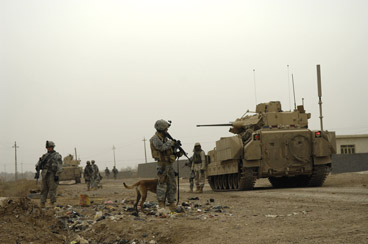 |
TSgt. Harvey Holt (center) and his military working dog assist soldiers from the Army’s 1st Cavalry Division on a patrol in Kahn Bani Sahd, Iraq. (USAF photo by SSgt. Stacy L. Pearsall) |
After the basic 79-day course comes 14 days at Yuma Proving Ground in Arizona, where the teams get a full-blown dress rehearsal for Iraq. Here they take helicopter rides, witness extensive gunfire, climb ladders, and search mock Iraqi villages, complete with other dogs and livestock.
The Air Force plays a key role in the production of SSD teams. The skills are sophisticated and perishable—development of the SSD training capability took five years to ramp up to production of 100 teams per year. Trends in global conflict and counterinsurgency operations indicate a long-term need for Specialized Search Dog capability. Until the IED threat vanishes, the Air Force-trained search dogs will be on the hunt for explosives and saving American lives.
Robert R. Milner Jr. retired from the Air Force Reserve in 1995. He is a graduate of Air Command and Staff College and the Air War College and the author of several books and articles on working dogs. He has deployed numerous times with Tennessee’s Disaster Search Dog program as a Canine Handler, Search Team Manager, and Task Force Leader. This is his first article for Air Force Magazine.